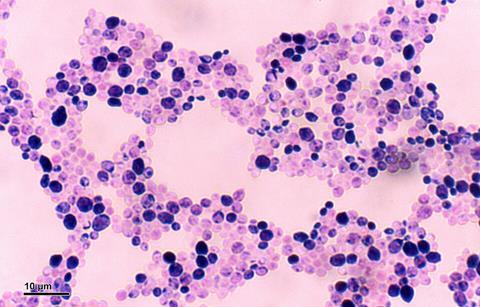Researchers at the Optics and Photonics Research Center (CePOF) have succeeded in increasing the susceptibility of the fungus Candida albicans to drug treatment through light-activated therapy.

The results of the study offer a promising alternative in the fight against antimicrobial resistance, a growing global problem that occurs when bacteria, viruses, fungi, and other parasites develop genetic mutations that render them resistant to drugs.
In the study, published in the journal Photochemistry and Photobiology, the researchers evaluated photodynamic inactivation (PDI) combined with the antifungal amphotericin B (AmB) to control the growth of the fungus, particularly its yeast (single-celled) and hyphae (filamentous colony) forms.
READ MORE: Turmeric teamed with light can help ward off superbugs
READ MORE: Photodynamic action weakens resistance to antibiotics in bacteria that attack airways
The results showed that combining the two treatments reduced the C. albicans growth by 75% in the yeast form and by 87.5% in the hyphae form. In addition, two sessions of PDI further increased antifungal efficacy, particularly against hyphae, which were more sensitive to the treatment.
Blue light activation
“It’s a technique that consists of using a molecule [in this case curcumin] and activating it with blue light. Activation, in the presence of oxygen, causes the molecule to produce free radicals, thereby inducing oxidative stress, killing or weakening the pathogen,” explains Vanderlei Bagnato, coordinator of CePOF, a FAPESP Research, Innovation, and Dissemination Center (RIDC) based at the São Carlos Institute of Physics of the University of São Paulo (IFSC-USP) in Brazil.
“In the case of C. albicans, mainly in the hyphae, which form a biofilm that’s almost impenetrable to drugs, photodynamic therapy was able to ‘break’ these colonies, resulting in the potentiation of the antifungal effect.”
The study involved photodynamic inactivation using 2.5 μM (micrometers) curcumin, which was activated by 450 nm (nanometers) LED light and different concentrations of the antifungal AmB.
An imminent danger
C. albicans is naturally present in the human body and is usually harmless. However, it can cause skin manifestations such as thrush or vaginal candidiasis. In more serious cases, the fungus can cause systemic candidiasis, an invasive blood infection. This serious condition is being diagnosed more frequently in intensive care units (ICUs) due to the growing number of immunocompromised patients and increased microbial resistance.
“There’s growing resistance to fungi, and C. albicans is no exception. It’s a very common fungus, but there are already cases of patients who have died from resistant systemic infections. Therefore, it’s very important to anticipate the problem and present an alternative that allows for more effective combat against the fungus without side effects or the need for excessive medication use,” says Gabriela Gomes Guimarães, a researcher at CePOF and first author of the study.
Guimarães explains that the decision to begin photodynamic inactivation tests on fungi using C. albicans was motivated by the two morphologies of the species. “The fungus forms both yeasts and hyphae, which form biofilms. Therefore, the fact that it worked so well for C. albicans gives us confidence to conduct new tests on other species, such as C. auris, an emerging fungus that’s causing concern, has shown resistance to treatment, and can be fatal,” says the researcher.
Applications in food
In addition to testing the effects of photodynamic therapy on other fungal species that pose a threat to human health, the researchers will conduct studies focused on food safety. “The proof of principle we’ve just published on C. albicans allows us to conduct studies on the application of photodynamic therapy in food decontamination. Fungi are also a problem in grain contamination, for example. Therefore, our next step is to test the application of this technique in storage silos, for example,” Bagnato anticipates.
CePOF has been conducting various laser research projects aimed at advancing treatments for bacteria, viruses, and other diseases, including cancer and fibromyalgia (agencia.fapesp.br/50500).
“The principle is always the same: activate a molecule with a laser so that it oxidizes. What varies in each case is the application, the amount of light, color temperature, amount of drug, and how much of the pathogen is eliminated or inactivated,” Bagnato summarizes.
Human health
Jennifer Soares, a member of CePOF and a FAPESP scholarship recipient, explains that the researchers are also concerned with using molecules that are compatible with human health and the environment.
“Curcumin, for example, is a compound found in curry and has already been approved for use in humans. But there’s also concern about how to apply the light. Our studies have shown that blue light, due to its wavelength, is ideal for treating superficial infections such as in the throat. That’s why we’re developing devices capable of illuminating the tonsils, for example. Red or infrared light, on the other hand, is more suitable for treating deep infections, such as pneumonia, which requires devices adapted to illuminate the chest area,” she explains.
CePOF also conducts studies focused on treating cervical cancer by applying medication and photosensitizing molecules through specific routes, such as the intravaginal canal.
Topics
- Amphotericin B
- Antimicrobial Resistance
- Biofilms
- Candida albicans
- curcumin
- Food Security
- Fungi
- Gabriela Gomes Guimarães
- Infection Prevention & Control
- Infectious Disease
- Jennifer Soares
- One Health
- Optics and Photonics Research Center
- photodynamic inactivation
- Research News
- The Americas
- University of São Paulo
- Vanderlei Bagnato







No comments yet